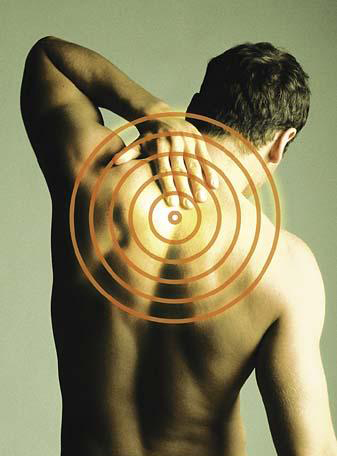Read More About Back Pain Treatments from Physio Leeds
The spine is made up of many bones called vertebrae. These are roughly circular and between each vertebra is a disc. The discs are made of strong rubber-like tissue which allows the spine to be fairly flexible. A disc has a stronger fibrous outer part and a softer jelly-like middle part called the nucleus pulposus.
The spinal cord, which contains the nerves that come from the brain, is protected by the spine. Nerves from the spinal cord come out from between the vertebrae to relay messages to and from various parts of the body.
Strong ligaments attach to the vertebrae. These give extra support and strength to the spine. Various muscles also surround, and are attached to, various parts of the spine.
When you have a ‘slipped’ (prolapsed) disc, a disc does not actually slip. What happens is that part of the inner softer part of the disc (the nucleus pulposus) bulges out (herniates) through a weakness in the outer part of the disc. The bulging disc may press on nearby structures such as a nerve coming from the spinal cord.

Some of the Main Causes of Back Pain
Various things may trigger the inner softer part of the disc to prolapse out through the weakened outer part of the disc. For example, sneezing, awkward bending, or heavy lifting in an awkward position may cause some extra pressure on the disc. In people with a weakness in a disc, this may be sufficient to cause a prolapse. Factors that may increase the risk of developing a prolapsed disc include:
Nerve root pain is pain that occurs because a nerve coming from the spinal cord is pressed on (trapped) by a ‘slipped’ (prolapsed) disc, or is irritated by the inflammation caused by the prolapsed disc. Although the problem is in the back, you feel pain along the course of the nerve in addition to back pain. Therefore, you may feel pain down a leg to the calf or foot. Nerve root pain can range from mild to severe but it is often worse than the back pain. With a prolapsed disc, the sciatic nerve is the most commonly affected nerve. The sciatic nerve is a large nerve that is made up from several smaller nerves that come out from the spinal cord in the lower back. It travels deep inside the buttock and down the back of the leg. There is a sciatic nerve for each leg.
Utilising Physiotherapy for Back Pain Treatment
Physiotherapy treatment from Physioleeds can manage your disc prolapse effectively using manual handling techniques, a home exercise program and advise on the avoidance of specific movements which could have caused the disc prolapse.
Cauda Equina Syndrome – rare, but an emergency
Cauda equina syndrome is a particularly serious type of nerve root problem that can be caused by a prolapsed disc. This is a rare disorder where the nerves at the very bottom of the spinal cord are pressed on. This syndrome can cause low back pain plus:
Problems with bowel and bladder function (usually inability to pass urine).
Numbness in the saddle area around the back passage (anus).
Weakness in one or both legs.
This syndrome needs urgent treatment to preserve the nerves to the bladder and bowel from becoming permanently damaged. See a doctor immediately if you develop these symptoms.
Sciatica
The sciatic nerve exits both sides of the lumbar spinal levels (L4-5 and S1) and continues through the buttocks, down the back of the thighs, into the back and outer portion of the lower legs and into the outside border of each foot. Sciatica is pain somewhere along the length of the sciatic nerve and it should be, however, pointed out that back pain can be absent.
Sciatica can be caused by a prolapsed disc, abnormal spinal movement at the level of the nerve root, or wear and tear of the associated lumbar joints, causing reduced space for the nerve root and consequent compression of the sciatic nerve.
Other causes of sciatic-type pain include a tight Piriformis muscle (a deep buttock muscle overlying the sciatic nerve), lumbar spine facet joint dysfunction or sacroiliac joint dysfunction.
Physiotherapy can be very successful in resolving these symptoms by using posture correction, manual therapy techniques, exercise and neural mobilisation.
For more information about how physiotherapy, and our range of back pain treatments, can help you, contact us today.
PhysioLeeds Fit4Work, Bankside, 71 Breary Lane East, Bramhope, Leeds, LS16 9EU
PhysioLeeds Fit4Work, Trinity Fitness, Brownberrie Lane, Horsforth, Leeds, LS18 5HD
